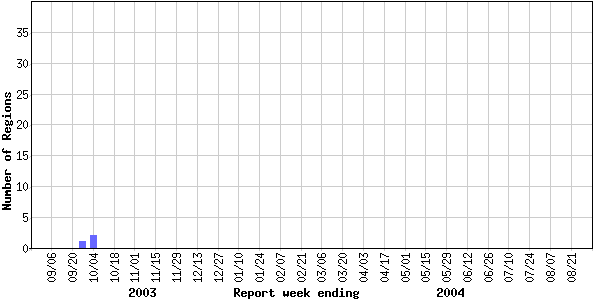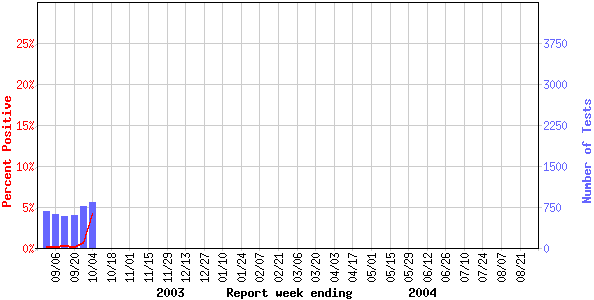|
|
|
Canada:
Sporadic influenza activity is reported in parts of Ontario and
localized influenza activity is reported in Alberta and Saskatchewan in
week 40. During the week ending October 4 (week 40), sentinel physicians
reported 26 cases of influenza-like illness (ILI) per 1000 patient visits,
which is slightly above baseline rates for week 40. Since week 38, ILI rates
have been highest among the 5 to 19-year-olds age group, with 47 ILI cases
per 1000 patient visits reported during week 40. During the two week period,
September 21 to October 4, Health Canada received 1588 reports of laboratory
tests for influenza, including 40 (2.51%) influenza A detections (in Saskatchewan
and Alberta) and 0 (0.00%) influenza B detection (see table).
During week 40, influenza outbreaks were reported in two long-term care
facilities (one
in Alberta and one in Saskatchewan) and in one hospital (Saskatchewan).
United
States:
The 2002-2003 influenza surveillance period ended for the season on May 17,
2003 (week 20). Surveillance will resume October 13, 2003.
CDC: <http://www.cdc.gov/ncidod/diseases/flu/weekly.htm>
International:
WHO: Influenza activity continues to be detected in Hong Kong with Influenza
A (H3N2) viruses predominating. Australia is reporting that cases of influenza
are subsiding after one of the biggest influenza seasons since 1998. The
peak incidence occurred in August; influenza A (H3) viruses have been responsible
for these outbreaks with virtually no A(H1) nor B viruses isolated to date.
EISS: Ireland is reporting its first influenza outbreak
in a school; until now only isolated cases of influenza in two European countries
have been reported.
Eurosurveillance Weekly: A new avian influenza
virus (H5N7) has been identified in tissue samples of several ducks of an
exterminated flock
in Denmark. This new virus has not been identified in any humans, including
those who had close contact with the flock.
WHO: <http://rhone.b3e.jussieu.fr/flunet/www/index.html>
EISS: <http://www.eiss.org>
Eurosurveillance Weekly: <http://www.eurosurveillance.org/ew/2003/030925.asp>
SARS:
Learning from SARS: Renewal of Public Health in Canada, the report of the
National Advisory Committee on SARS and Public Health is now available on
the Health Canada Web site.
Heath Canada: http://www.hc-sc.gc.ca/english/pdf/sars/sars-e.pdf |

Total number of influenza tests
performed and number of positive tests by province/territory of testing
laboratory, Canada, 2003-2004
Province
of
reporting
laboratories |
Report
Period:
September 21 - October 4, 2003 |
Season
to Date:
August 24, 2003 - October 4, 2004 |
Total #
Influenza
Tests |
# of
Positive Tests |
Total #
Influenza
Tests |
# of
Positive Tests |
| Influenza
A |
Influenza
B |
Total |
Influenza
A |
Influenza
B |
Total |
| NL |
4 |
0 |
0 |
0 |
7 |
0 |
0 |
0 |
| PE |
1 |
0 |
0 |
0 |
3 |
0 |
0 |
0 |
| NS |
21 |
0 |
0 |
0 |
56 |
0 |
0 |
0 |
| NB |
6 |
0 |
0 |
0 |
34 |
0 |
0 |
0 |
| QC |
200 |
0 |
0 |
0 |
557 |
0 |
1 |
1 |
| ON |
507 |
0 |
0 |
0 |
1397 |
4 |
0 |
4 |
| MB |
98 |
0 |
0 |
0 |
221 |
0 |
0 |
0 |
| SK |
167 |
14 |
0 |
14 |
585 |
14 |
0 |
14 |
| AB |
520 |
26 |
0 |
26 |
1151 |
27 |
0 |
27 |
| BC |
64 |
0 |
0 |
0 |
167 |
0 |
0 |
0 |
| Canada |
1588 |
40 |
0 |
40 |
4178 |
45 |
1 |
46 |
|
Specimens from NT, YT, and NU are sent to reference laboratories in
other provinces.
Note: Cumulative data includes updates to previous weeks; due to
reporting delays, the sum of weekly report totals do not add up to cumulative
totals.
Abbreviations: Newfoundland/Labrador (NL), Prince Edward Island
(PE), New Brunswick (NB), Nova Scotia (NS), Quebec (QC), Ontario (ON), Manitoba
(MB), Saskatchewan (SK), Alberta (AB), British Columbia (BC), Yukon (YT),
Northwest Territories (NT), Nunavut (NU)
Respiratory virus laboratory detections in Canada, by geographic regions,
are available weekly on the following website:
<http://www.phac-aspc.gc.ca/bid-bmi/dsd-dsm/rvdi-divr/index.html>

Number of influenza surveillance
regions† reporting widespread or localized influenza activity, Canada,
by report week, 2003-2004 (N=52)


† sub-regions within the province or territory as defined by the provincial/territorial
epidemiologist. Graph may change as late returns come in.


Influenza tests reported and percentage
of tests positive, Canada, by report week, 2003-2004



Percent positive influenza tests,
compared to other respiratory viruses by reporting week, Canada, 2003-2004



Influenza strain characterization,
Canada, cumulative, 2003-2004 influenza season by the Respiratory Viruses
Section at the National Microbiology Laboratory
[N=0]
NACI recommended components of the 2003-2004 Canadian vaccine include:
an A/New Caledonia/20/99 (H1N1)–like virus, an A/Panama/2007/99 (H3N2)-like
virus and either a B/Hong Kong/330/2001-like or B/Shangdong/7/97-like virus. Note: the influenza A(H1N2) virus strain is a reassortment virus derived
from the influenza A (H1N1) and A(H3N2) virus strains. This strain circulated
widely during the 2001-2002 season and like last season the current vaccine
is expected to provide protection against this virus.
See http://www.phac-aspc.gc.ca/publicat/ccdr-rmtc/03vol29/acs-dcc-4/index.html

Influenza-like illness (ILI) reporting
rates, Canada, by report week, 2003-2004 compared to 1996/97 through 2002/2003
seasons


Note: No data available for mean rate in previous years for weeks 21 to 39
(1996-1997 through 2002-2003 seasons). During weeks 20-39, 2002-2003/ 2003-2004
seasons, ILI is reported once every two weeks, on even weeks only

Number of Outbreaks in Long Term
Care Facilities by Report Week, Canada, 2003-2004



|





